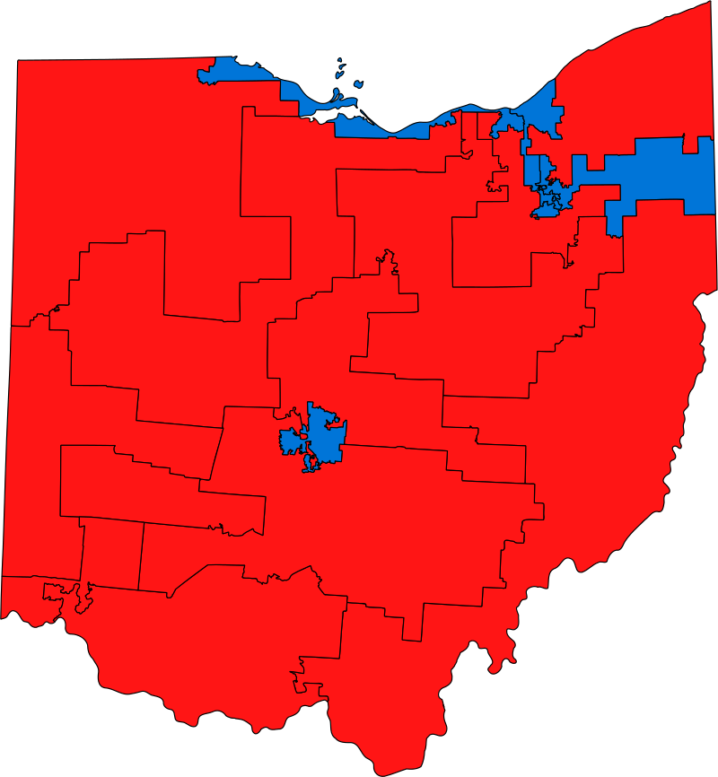BY SUSAN TEBBEN
With one week to go before the first official deadline for the congressional district maps in Ohio, how and when the process will start is still unknown with one chamber leader anticipating yet another blown constitutional deadline.
At a Fair Districts Ohio rally earlier this week across from the Statehouse, advocacy groups pushed forward in their targeting of partisan gerrymandering, but also remained critical of the process thus far.
“The legislative branch can not operate as it should when polarization is built into the system,” said Brandi Slaughter, executive director of the Ohio Council of Churches and member of the Fair Districts Ohio coalition.
The process for legislative districts just ended with a four-year map approved along party lines by the Ohio Redistricting Commission on Sept. 15. Whether or not those maps will stand will depend on expected court challenges.
As the process moves forward, the criticism is already flowing in for the congressional map-making, especially because it has yet to begin.
Under the constitutional amendment passed in 2015, the first deadline for Ohio legislators to bring forth a map of the state’s congressional districts was set for Sept. 30.
Legislative leaders like state Senate President Matt Huffman have already said that deadline is likely to expire without any action.
Spokespeople for both the House Republicans and Senate Democrats said there was no update to the process as of Wednesday morning.
But one piece of progress was made on Wednesday in a measure tagged on to House Bill 92. The bill was originally written regarding child abuse in military families, but had an amendment added to “codify rules adopted by the Ohio Redistricting Commission to ensure the creation of a website for public comment, submission and viewing of proposed congressional redistricting plans.”
“We gotta hurry up and get this knocked out,” state Sen. Frank Hoagland, in discussing the redistricting addition.
The bill passed unanimously in the Ohio Senate on Wednesday.
A state representative says another measure to help move along the process and keep it fair has remained idle in the Ohio House, and she’s calling on redistricting commission co-chair and House Speaker Bob Cupp to schedule hearings.
House Bill 313 has been in the House Government Oversight Committee since May, and would focus on transparency requirements within the redistricting process, and create a joint legislative committee to hold hearings on congressional maps.
“Though we’re halfway through the process, we should not lose sight of the need to ensure the deliberations of the legislature and the Redistricting Commission be transparent and accessible,” state Rep. Paula Hicks-Hudson, D-Toledo, said of her bill.
If the state legislature does not meet the Sept. 30 deadline, the congressional mapping process goes back to the commission, who will have until the end of October to come to an agreement.

***
Also from Ohio Capital Journal:
Commentary: Ohio GOP leaders broke promises, failed us all by creating more rigged maps
The oddest part is Ohio Gov. Mike DeWine acting as though he’s somehow powerless and had no choice when he voted to rig Ohio elections with partisan, gerrymandered maps for the next four years. After all, he’s only the governor.
It’s an absurd position. Maps were proposed to the commission that actually represent the 54-46 Republican to Democratic political split of Ohioans, as averaged over 16 partisan statewide elections, directly mirroring the 1.9 million to 1.6 million Republican to Democratic registered voter split of Ohioans. The majority of registered voters, 4.5 million, are unaffiliated.
GOP leaders instead awarded themselves more supermajorities, with a House breakdown of 62 seats to 37 Dems, and 23 to 10 in the Senate, according to their own figures. Dave’s Redistricting App projects a 65-seat GOP supermajority in the House. This is called cheating.
As one of the seven members on the 5-2 Republican to Democratic Ohio Redistricting Commission, DeWine had a vote. As did fellow Republicans Ohio Secretary of State Frank LaRose, Ohio Auditor Keith Faber, Senate President Matt Huffman, and House Speaker Bob Cupp, and two Democrats, their House Leader Emilia Sykes and state Sen. Vernon Sykes. READ MORE
Energy efficiency bill gets bipartisan push
An Ohio House committee began its work Wednesday on legislation designed to incentivize utility companies to boost the energy efficiency of their customers’ homes.
House Bill 389, a bipartisan effort backed by several large Ohio utilities and environmental advocates alike, would restore some components of Ohio’s energy efficiency law, which was gutted by 2019 legislation that’s now at the center of a Statehouse bribery scandal.
The bill allows utility companies to charge residential customers a maximum of $1.50 per month and spend it improving their homes’ energy efficiency, especially through rebates on efficient appliances or technology like smart thermostats.
“The cheapest energy is the kind that doesn’t get used,” said one of the bill’s sponsors, House Majority Leader Bill Seitz, R-Green Twp., to the House Energy and Public Utilities Committee. READ MORE





